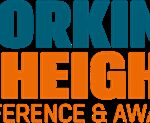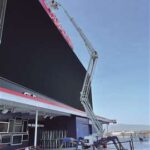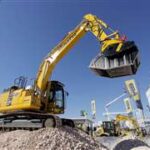mast lift (or vertical mast lift) operates by using a vertical mast system to raise and lower a platform, providing access to elevated work areas. The basic mechanism of a mast lift involves a combination of hydraulic or electric power, a vertical mast, and a lifting platform. Here’s a breakdown of how a typical mast lift works:
1. Vertical Mast and Lift Mechanism
-
The Mast: The mast is a vertical structure that acts as the central component of the lift system. It is typically made of strong, lightweight materials such as steel or aluminum.
-
Raising and Lowering: The lift mechanism is powered by either hydraulic cylinders (for lifting) or electric motors. The platform is attached to the mast, and the lift raises and lowers by extending or retracting the mast, moving the platform in a straight up-and-down motion.
2. Power Source
-
Electric Drive: Most modern mast lifts are powered by electric motors and batteries, making them ideal for indoor use. Electric power is more environmentally friendly, quieter, and doesn’t produce emissions, which is particularly important in confined spaces like warehouses, stores, or offices.
-
Hydraulic System: Some larger or industrial models use hydraulic systems to lift the mast. Hydraulic systems are powerful and can lift heavier loads, but they are often used in more rugged environments and larger models.
3. Control System
-
Operator Controls: The mast lift is controlled by an operator using a control panel located on the platform. The operator can raise or lower the platform using buttons or joysticks. These controls manage the power to the motor or hydraulic system, dictating how the lift moves.
-
Emergency Controls: Many mast lifts also come with emergency stop buttons or a manual lowering system that can be used in case of power failure or malfunction.
4. Platform and Safety Features
-
Platform: The platform, where the worker stands, is mounted at the top of the mast and moves vertically as the mast extends or retracts. The platform typically has guardrails for safety and can be made of anti-slip materials to prevent accidents.
-
Safety Features: Most modern mast lifts are equipped with several safety features such as:
-
Guardrails: To prevent workers from falling off.
-
Outriggers: Stabilizing arms that can be deployed on the ground to enhance stability when the lift is in use.
-
Tilt Sensors: Some lifts include sensors to detect when the unit is tilting or unstable, preventing operation if the lift is at an unsafe angle.
-
Load Sensors: Ensure the lift isn’t overloaded beyond its capacity, preventing strain on the system.
-
5. Stabilization and Movement
-
Stabilizing the Lift: As the platform rises, the mast lift’s stabilization system ensures that the unit stays upright. Many models come with outriggers or wheeled bases that provide additional support and prevent tipping, especially when the platform is elevated to its maximum height.
-
Movement in Tight Spaces: Mast lifts are designed to be highly maneuverable, often equipped with steering controls that allow operators to move the lift easily through tight aisles or small spaces, especially in indoor environments like warehouses or stores.
6. Mast Lift Types and Height Range
-
Standard Vertical Mast Lift: Most vertical mast lifts offer working heights between 10 to 50 feet (3 to 15 meters), providing excellent access to higher levels while keeping the footprint small.
-
Narrow Aisle Models: Some mast lifts are designed specifically for narrow aisles, allowing operators to move the lift through tight spaces between shelves or machinery.
-
Rough Terrain Models: In outdoor environments or construction sites, larger mast lifts may feature wider bases and larger tires to handle rough, uneven terrain while providing stable access at height.
How It Works in Steps:
-
Positioning: The operator moves the lift to the desired location. Depending on the model, the lift may need to be stabilized with outriggers if required.
-
Raising the Platform: The operator activates the lift controls, and the mast extends upwards. If it’s a hydraulic model, hydraulic fluid is pumped into cylinders that extend the mast. For electric models, motors drive the lifting system.
-
Elevated Work: Once the platform reaches the desired height, the operator can work on the elevated surface. The platform remains steady while the mast lift holds the position.
-
Lowering: When the work is complete, the operator activates the controls to lower the platform back down. The mast retracts, and the platform returns to the ground level.
-
Mobility: After lowering, the lift can be moved to another location for additional tasks.
Summary of Key Components:
-
Vertical Mast: The core structure that provides the lift’s upward motion.
-
Control System: Operated by the worker on the platform to raise, lower, and maneuver the lift.
-
Power Source: Electric or hydraulic systems that drive the lift.
-
Platform: The surface where the worker stands, equipped with safety features like guardrails and anti-slip surfaces.
-
Stabilizers: Optional supports (outriggers) to stabilize the lift when elevated.
A mast lift operates by using either electric or hydraulic power to raise and lower a vertical mast, carrying a platform for workers to perform tasks at height. The lift’s compact size, combined with its straightforward vertical movement, makes it ideal for confined spaces, narrow aisles, and indoor tasks like maintenance, inventory management, and repairs.




